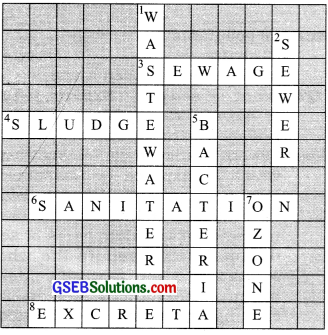Gujarat Board GSEB Textbook Solutions Class 7 Science Chapter 18 Wastewater Story Textbook Questions and Answers, Notes Pdf.
Gujarat Board Textbook Solutions Class 7 Science Chapter 18 Wastewater Story
Gujarat Board Class 7 Science Wastewater Story Textbook Questions and Answers
Question 1.
Fill in the blanks:
Cleaning of water is a process of removing ………..
Wastwater released by houses is called …………
Dried …………. is used as manure.
Drains get blocked by ………… and
(a) pollutants
(b) sewage
(c) sludge
(d) chemicals, kitchen waste
Question 2.
What is sewage? Explain why it is harmful to discharge untreated sewage into rivers or seas.
Answer:
Sewage is a liquid containing wastes which is disposed of by households, industrial and agricultural activities in the water. It is harmful to discharge untreated sewage into rivers or seas because it can pollute the whole sources of water. Sewage contains harmful substances and disease-causing organisms.-It is therefore dangerous to release untreated sewage into water bodies.
![]()
Question 3.
Why should oils and fats be not released in the drain? Explain.
Answer:
Oils and fats should not be released in drains because they harden the soil in the pipes and block them. Fats get clogged in holes of the soil in the drain and block it. It does not allow the water to flow.
Question 4.
Describe the steps involved in getting clarified water from wastewater.
Answer:
Following steps are involved in the purification of water:
1. Firstly all the physical impurities like stones, plastic bags, cans, etc. are to be removed. It is done by passing the water through bar screens.
2. Then water is taken to grit and sand removal tank where impurities are removed by sedimentation.
3. Solid impurities and feces etc. are collected from the bottom of the water. These impurities collected are called sludge.
4. Clarified water is cleaned of other impurities by the aerator. All disease-causing bacteria are removed by chlorination.
Question 5.
What is sludge? Explain how it is treated.
Answer:
Sludge is the collected solid waste from the wastewater during the treatment in the water treatment plant. Sludge is decomposed in a separate tank by the anaerobic bacteria. Activated sludge is used as manure.
![]()
Question 6.
Untreated human excreta is health. hazard. Explain.
Answer:
Untreated human excreta can cause a lot of health-related problems. It pollutes water, air, and soil. The polluted water contains disease-causing bacteria which can spread epidemics like cholera, meningitis etc.
Question 7.
Name two chemicals used to disinfect water.
Answer:
Chlorine and ozone
Question 8.
Explain the function of bar screens in a wastewater treatment plant.
Answer:
Bar screens clear the wastewater of all the physical impurities. Large size waste like napkins, plastics, cans etc. are removed from the wastewater through the bar screens.
Question 9.
Explain the relationship between sanitation and disease.
Answer:
Sanitation and disease are related to each other. Sanitation involves proper disposal of sewage and refuses from the house and public places. If sanitation is there, no disease will occur, but if sanitation is not there various types of disease will occur and spread. So sanitation should be maintained to avoid disease.
Question 10.
Outline your role as an active citizen in relation to sanitation.
Answer:
As an active citizen, we should take care of our personal environmental sanitation. We should make people aware of the benefits of sanitation. We should help municipal corporations to cover all the open drains and remove disease-causing substances thrown in open.
![]()
Question 11.
Here is a crossword puzzle. Good luck!

Across:
3. Liquid waste products
4. Solid waste extracted in sewage treatment
6. A word related to hygiene
8. The waste matter discharged from the human body
Down:
1. Used water
2. A pipe carrying sewage
5. Micro-organisms which cause cholera
7. A chemical to disinfect water
Answer:

Question 12.
Study the following statements about ozone:
(a) It is essential for the breathing of living organisms.
(b) It is used to disinfect water.
(c) It absorbs ultraviolet rays.
(d) Its proportion in air is about 3%. Which of these statements are correct?
(i) (a), (b) and (c)
(ii) (b) and (c)
(iii) (a) and (d)
(iv) All four
Answer:
(ii) (b) and (c)
![]()
Extended Learning – Activities And Projects
Question 1.
Construct a crossword puzzle of your own using the keywords.

Across:
1. A gas prepared by decomposition.
2. The network of sewers.
4. Solid waste which settles at the bottom.
Down:
3. Bacteria that require air.
5. A microorganism that causes cholera.
6. Essential for life.
Answer:
Hint:
Across:
- BIOGAS
- SEWAGE
- AEROBIC
Down:
- SLUDGE
- BACTERIA
- WATER
![]()
Question 2.
Then and now: Talk to your grandparents and other elderly people in the neighborhood. Find out the sewage disposal systems available to them. You can also write letters to people living in far off places to get more information. Prepare a brief report on the information you collected.
Answer:
Do it yourself.
Question 3.
Visit a sewage treatment plant.
It could be as exciting and enriching as a visit to a zoo, a museum, or a park. To guide your observation here are a few suggestions.
Record in your notepad:
Place ……….. Date ………..
Time ……….
Name of the official at the plant ………
Guide/ Teacher …………
(a) The location of the sewage plant.
(b) Treatment capacity.
(c) The purpose of screening as the initial process.
(d) How is air bubbled through the aeration tank?
(e) How safe is the water at the end of the treatment? How is it tested?
(f) Where is the water discharged after treatment?
(g) What happens to the plant during heavy rains?
(h) Is biogas consumed within the plant or sold to other consumers?
(i) What happens to the treated sludge?
(j) Is there any special effort to protect nearby houses from the plant?
(k) Other observations.
Answer:
Do it yourself with the help of your teacher/parents.